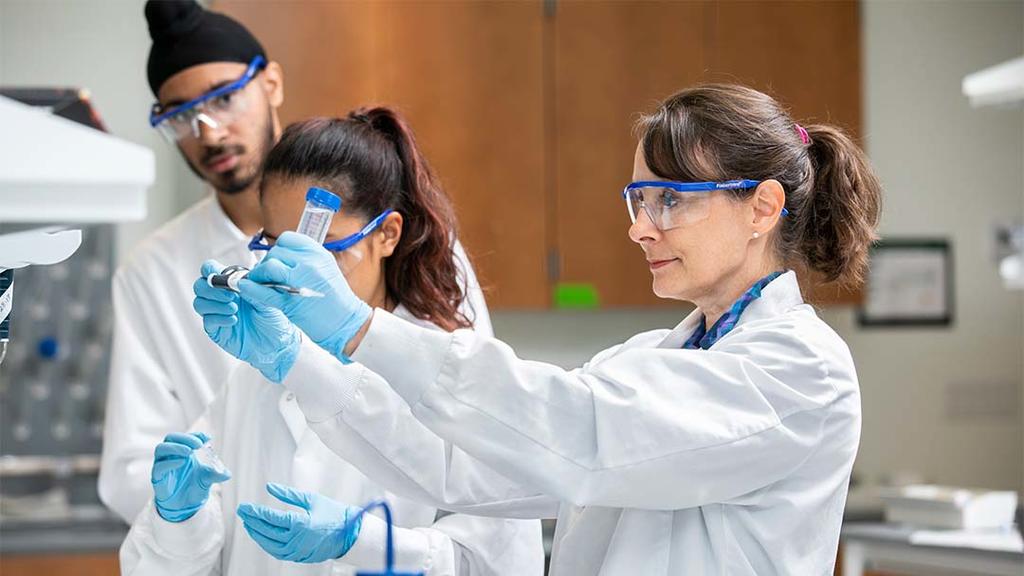"We’re working with orthopedic surgeons to understand how to guide the immune system in trauma patients to help heal broken bones and joints."
New materials and biologically-inspired nano-designs are revolutionizing disease treatments.
Faculty:
Ketul Popat, Chair and Professor
Caroline Hoemann, Professor
Remi Veneziano, Assistant Professor
We work with polymers, nanoparticles, lab-on-chip devices, and biologically-inspired designs to create novel systems that fulfill unmet needs in areas such as cancer, inflammatory disease, joint tissue repair, and next-generation vaccines.
Our areas of expertise:
Biomaterial-guided regenerative medicine
Tissue repair is naturally initiated by a blood clot, which releases factors that attract innate immune cells to guide the healing response.
We use biomaterials to engineer the blood clot so that tissues can regenerate with more durable and functional structures. Biomaterials made of polysaccharides, chains of sugar units, can be used to alter cell migration—a type of inflammation—and increase the number of blood vessels that are attracted to a repairing wound.
We are investigating new methods to sense and predict the healing potential of complex bone fractures, as well as to predict whether certain individuals are at risk for infection or delayed healing of traumatic bone fractures. Our lab is also designing biomaterial implants that stimulate therapeutic inflammation and help treat damaged bone and soft tissues in the knee joint. Principal investigator: Caroline Hoemann.

Caroline Hoemann, professor in the Bioengineering Department, is researching how to use biomaterials to guide the immune system to heal bone fractures and fight infection.
Bio-inspired nanoarchitectures for control of cell behavior
Nanoscale organization of bio-macromolecules on the cell membrane is crucial for numerous key biological mechanisms including antigen recognition by B-cell receptors as part of the adaptive immune response, pathogen entry into cells, and cell signaling.
We are developing biomimetic DNA nanoarchitectures to control the spatial organization of macromolecules and examine the role of antigen valency and organization in B-cell activation to further understand the macromolecular organization requirements needed for efficacious vaccines. We are also designing nanostructures that mimic the presentation of virus targeting moieties for efficient delivery of various therapeutic cargos. Principal investigator: Remi Veneziano.
Biomaterials Surface Micro/Nano-Engineering Laboratory
Surfaces that contain micro- and nanoscale features in a well-controlled, “engineered” and biomimetic manner have been shown to significantly affect cellular and subcellular function of various biological systems. Our research is focused towards using the tools of micro- and nanotechnology for applications in biomaterials and tissue engineering. The goal of current research is to design material surfaces that induce controlled, guided, and rapid healing in medical devices such as orthopedic implants, stents and heart valves. In addition to acceleration of normal wound healing phenomena, these implants should result in the formation of a characteristic interfacial layer with adequate biomechanical properties. To achieve these goals, however, a better understanding of events at the tissue-material interface is needed, as well as the development of new materials and approaches that promote biointegration. Our work proposes the use of well-controlled biomimetic nanostructured interfaces to enhance implant integration. We hypothesize that controlled biomimetic nanoscale architectures can promote cell differentiation and matrix production and enhance short-term and long-term integration, while prevent undesired responses such as infection and inflammation. Moreover, the ability to create model nano-dimensional constructs that mimics physiological systems can aid in studying complex tissue interactions in terms of cell communication, response to matrix geometry, and effect of external chemical stimuli. By understanding how physical surface parameters influence cells, we can more effectively design material surfaces that can be used in a clinical setting for medical devices. Principal Investigator: Ketul Popat
